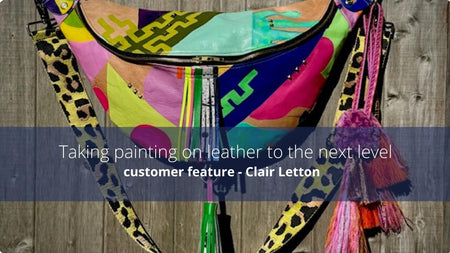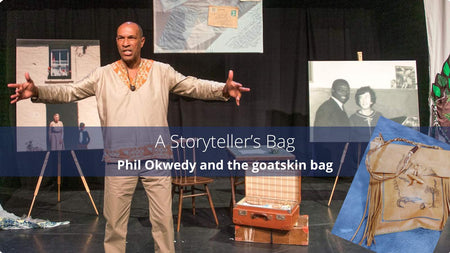
Article from David Turner
Profile – David is an experienced leatherworker and has been a fabulous tutor for us on our in-person workshops. He has done many different projects, is excellent at leather carving and tooling and has taken on all sorts of repairs over his career.
I have just worked out I’ve been “repairing” things on and off for sixty-eight years. That’s a lot of “mends” but how useful is that is to anybody without face-to-face conversation?
What are you repairing and why? Who’s paying? Is it for family, friend or money.
The romanticism of The Repair Shop and its huge success is lovely, but the show makes no mention of time or cost. The most you get is something like “this is a big job”. It is easy for me to work out that some of the jobs would easily cost over £1.000 done properly commercially. Without someone else (the BBC) footing the bill most jobs on The Repair Shop wouldn’t get done in that way.
Repair or restore, a good question?
Out of the hundreds and hundreds of jobs I’ve done the number who wanted restoration remains the smaller of the two. The main reason is the vast increase in the cost. I only ever have advertised as “Leather Workshop, Custom Made Leatherwork”. I didn’t advertise specifically for repair or restoration. What came, came anyway. I just wanted work, so a broad-based ad worked well. The work came and so did the repairs, all shapes and sizes. Was I ready, would I, could I cope?
I had stuck my head above the parapet, what was going to come through the door? Did I have enough equipment?
I will digress a little, over time I have looked at a lot of videos all sort of table top sized little items, all a bit of hand stitching, all a bit of pricking iron maybe a rivet or two and a bit of glue. Nearly all say they prefer hand stitching and don’t have, and or would not use a sewing machine. Lock stitch isn’t as good as hand sewing etc etc.
Out of digress, the first job through the door, a double gun bag for a pair of long barrel shot guns. Problem two new zips required and some tidying up. Now the zips are six feet long! There was the gun bag edge; outer layer of heavy canvas, a woolskin lining, and the zip. The layers are then leather bound. Often the three layers are stitched together first to make sure the zip sides are 100% even. Then the binding, that’s five thicknesses to go through!!! That is about forty-eight feet of stitching! As a repair nobody is going to pay you to do that by hand when the next guy has a sewing machine.
How do I cover myself against what comes through the door? Four industrial sewing machines. A skiving machine. Fly press. Big and two smaller vices. Pillar drill. Electric hand drills, a Dremel. An anvil and various lumps of metal. A small splitting machine. Hand tools, mauls mallets and hammers, a large selection spikes and awls, all sizes. These I have accumulated over the years and hopefully I can remember where it all is, what it’s for, and how to use it!
What is interesting about repairs? There is so much; if you like social history, are interested in heritage craft jobs that have all but disappeared, past fashions and noting the changes in society and the way we live.
For example in the 1970’s – non-stop repairs to sheepskin coats, embroidered Afgan coats, and badly tanned sheep and goatskins. The worst one of these stank something rotten and I had to repair it outdoors.
Other examples that I have done a lot - soft top zipped luggage. Corners burst open due to being thrown about at airports. Design changed. Duffle bags. Repair patches for thinning elbows on jackets cardigans and jumpers, mainly men. Sold with holes in or taken as a job.
With the rise of the supermarket the old traditional green grocers were disappearing. Root vegetables still had dirt on and most households had a heavy veg bag often leather sometimes canvas that was used regularly and never cleaned. This meant a hard life with stitching failure being common. When brought in some would not have been cleaned thoroughly. Thus it was not unknown to find some wildlife wiggling in the seams and gussets! Now all produce is washed and all those old bags gone, no more maggots! Capacity continues in many cases to be greater than the handles are designed for or can cope with. What doesn’t change is bag straps hangers and handles which are still the most common type of repair.
As to any special memories, anything that sticks out. One hundred and thirty feet of draft excluder for the ten foot high doors of Christchurch Priory. Try that without a machine! Two stitch lines, that’s two hundred and sixty feet of stitching. A superb Victorian briefcase restored so the four generations of family photos can be stored and handed down. 1890s Kenya crocodile takes a fancy to the locals. Customer’s great-great grandad is the man for the job. Dispatches miscreant reptile. Gratitude resulted in the gift of a cartridge bag made from part of the man eater. Job to restore bag so that it can be occasionally used.









Do you have a contact number for David please? I used him when he lived in Shropshire to fix my farrier’s chaps.
Comments from David Turner relating to The repair shop, there is very little I have done that comes up on the program. I always attempt to quantify the cost, and who pays for this? Unfortunately I tend to be a bit hard with some requests and tell the customer the truth. Making money from repairs is not easy, and the task has to be quality leather if you think it is recoverable. Taking a broken bag bought on holiday can be a disaster, I have been approached many times by customers that purchased leather goods on holiday, and believed they were good quality based on the cost. The cost was real but the quality was not, and you need to be a little hard on this. I made a shoulder bag for a retired teacher, she had paid a great deal of money for a hand bag from overseas and in one year was falling apart. I wouldn’t repair it as felt it would need a great deal of replacement pieces to repair it sensibly. A leather hand bag should last a life time if it is quality leather, and fittings too.